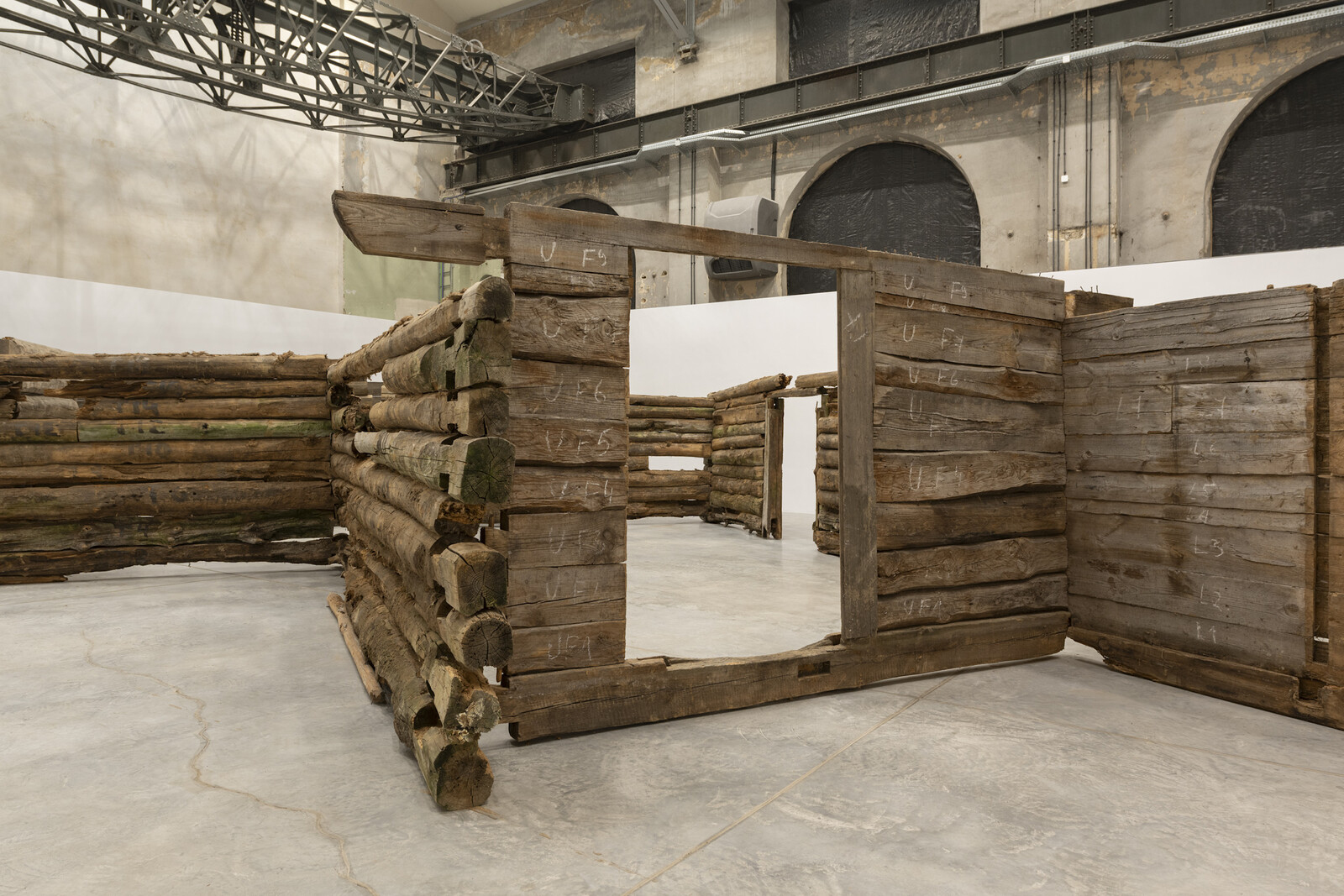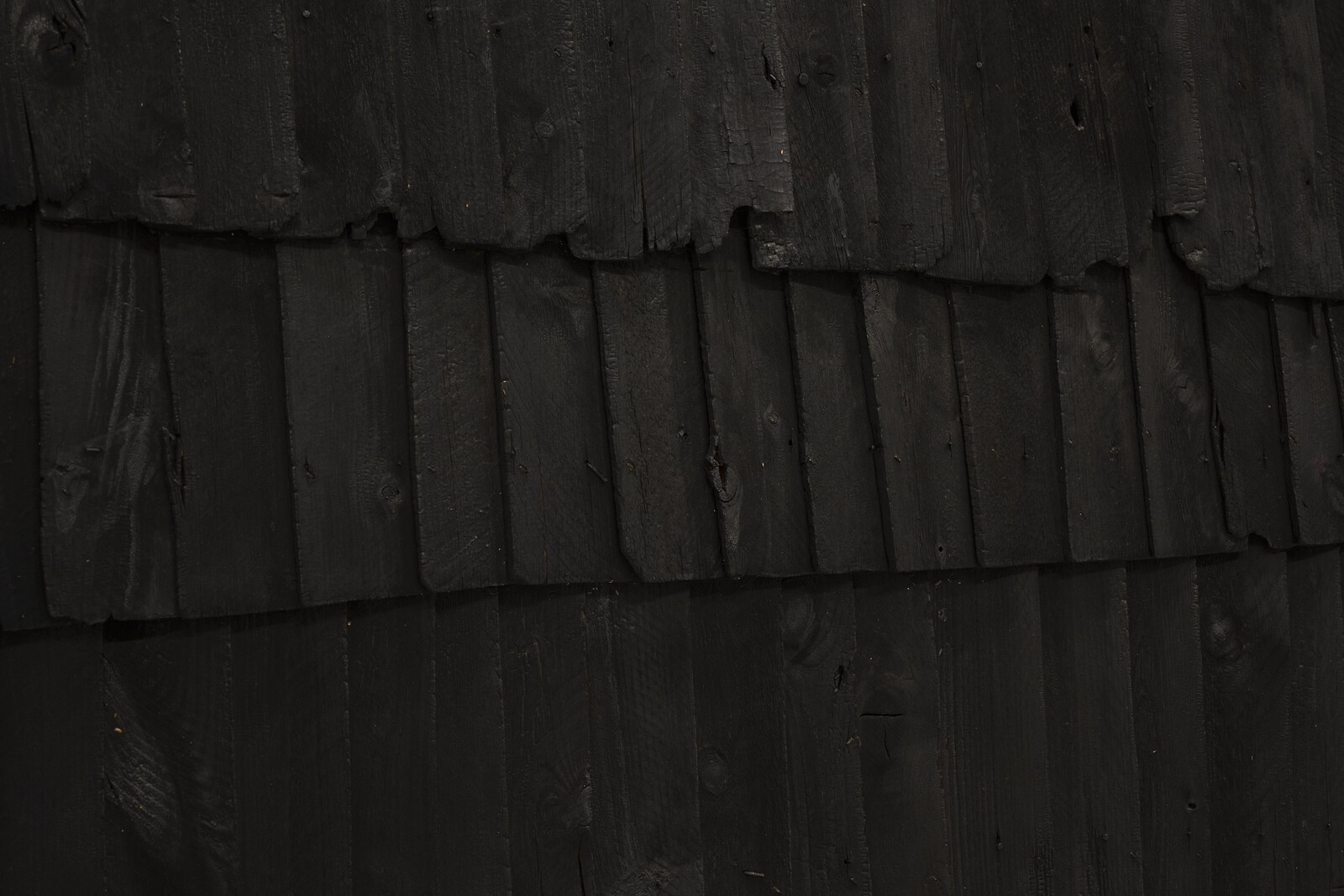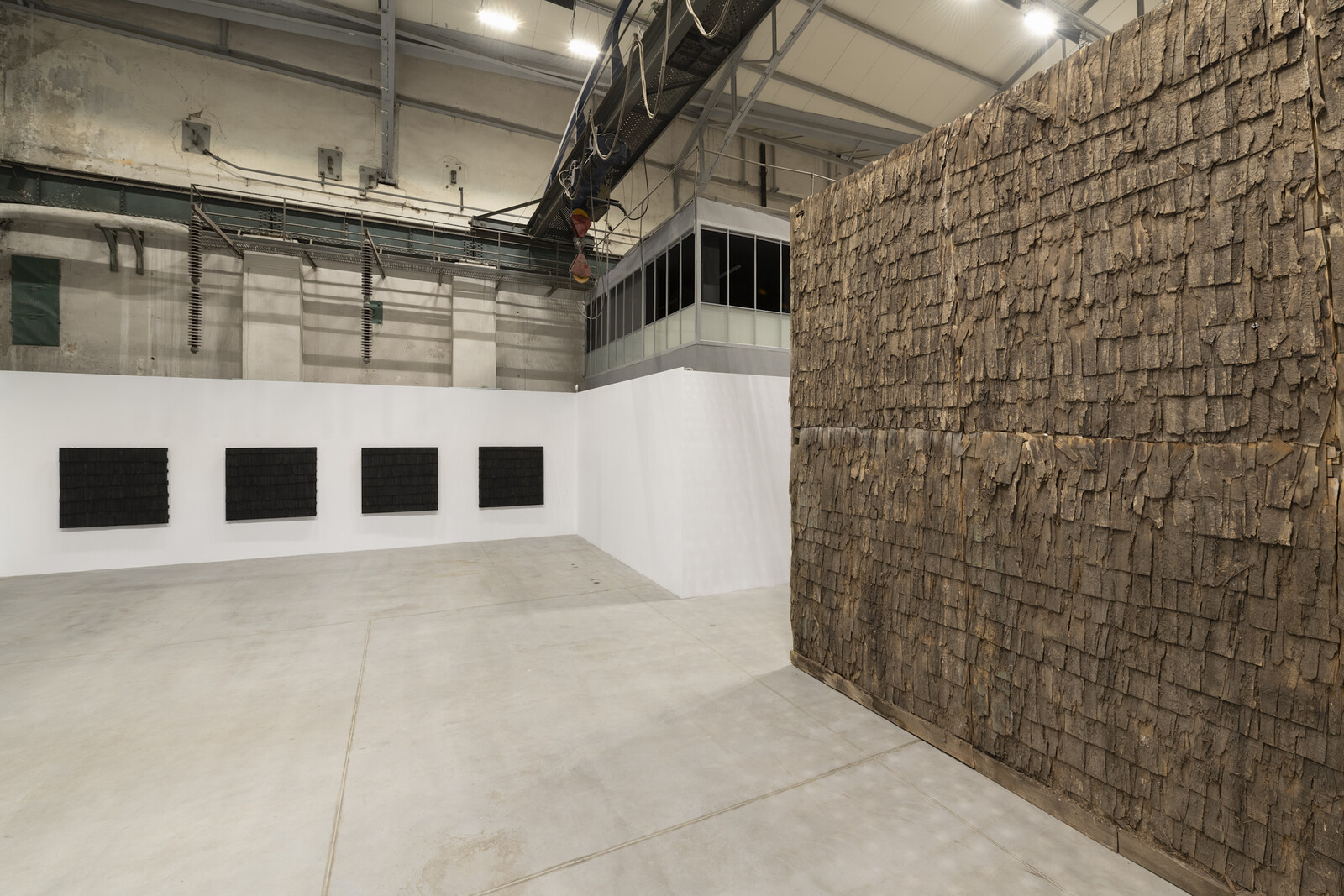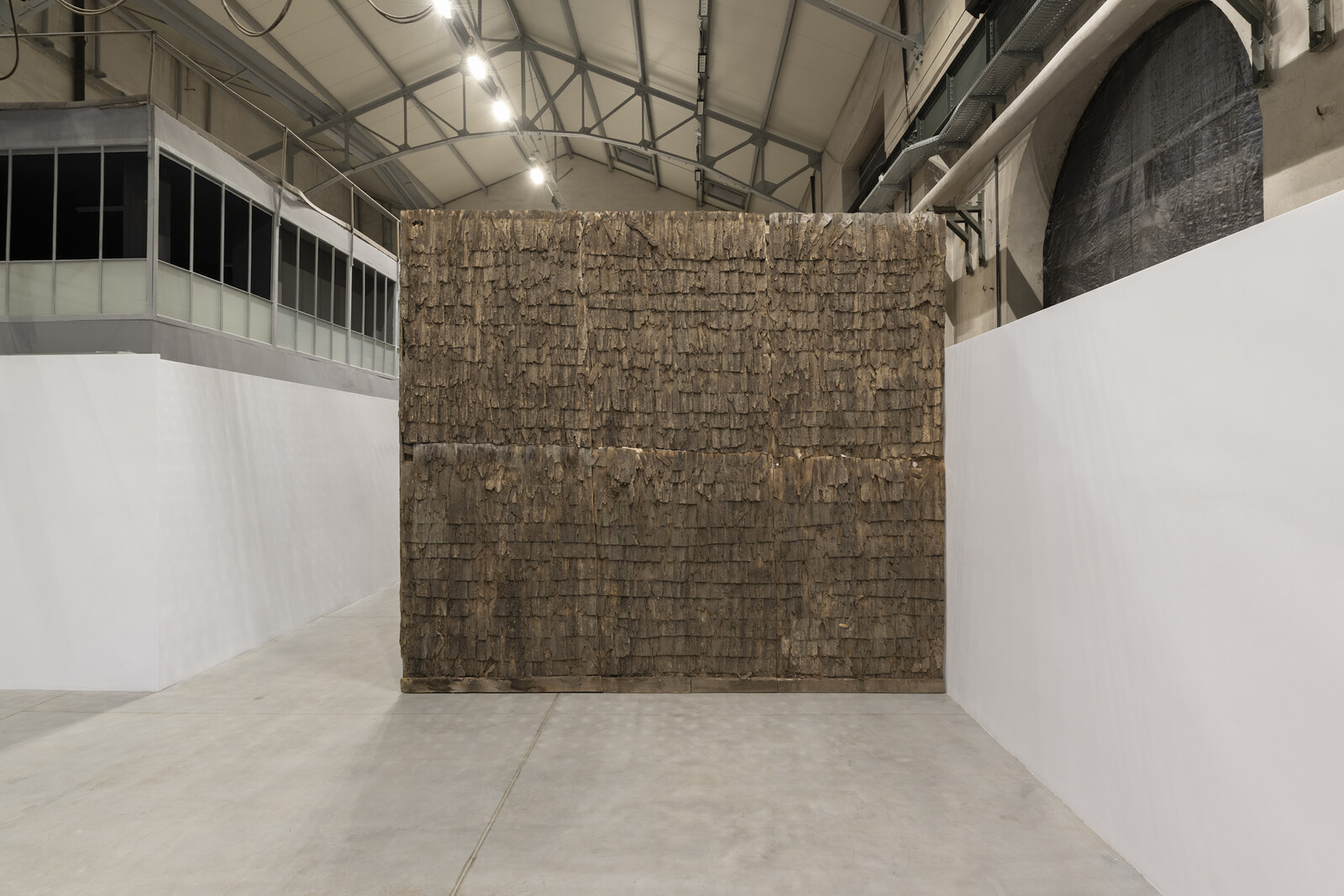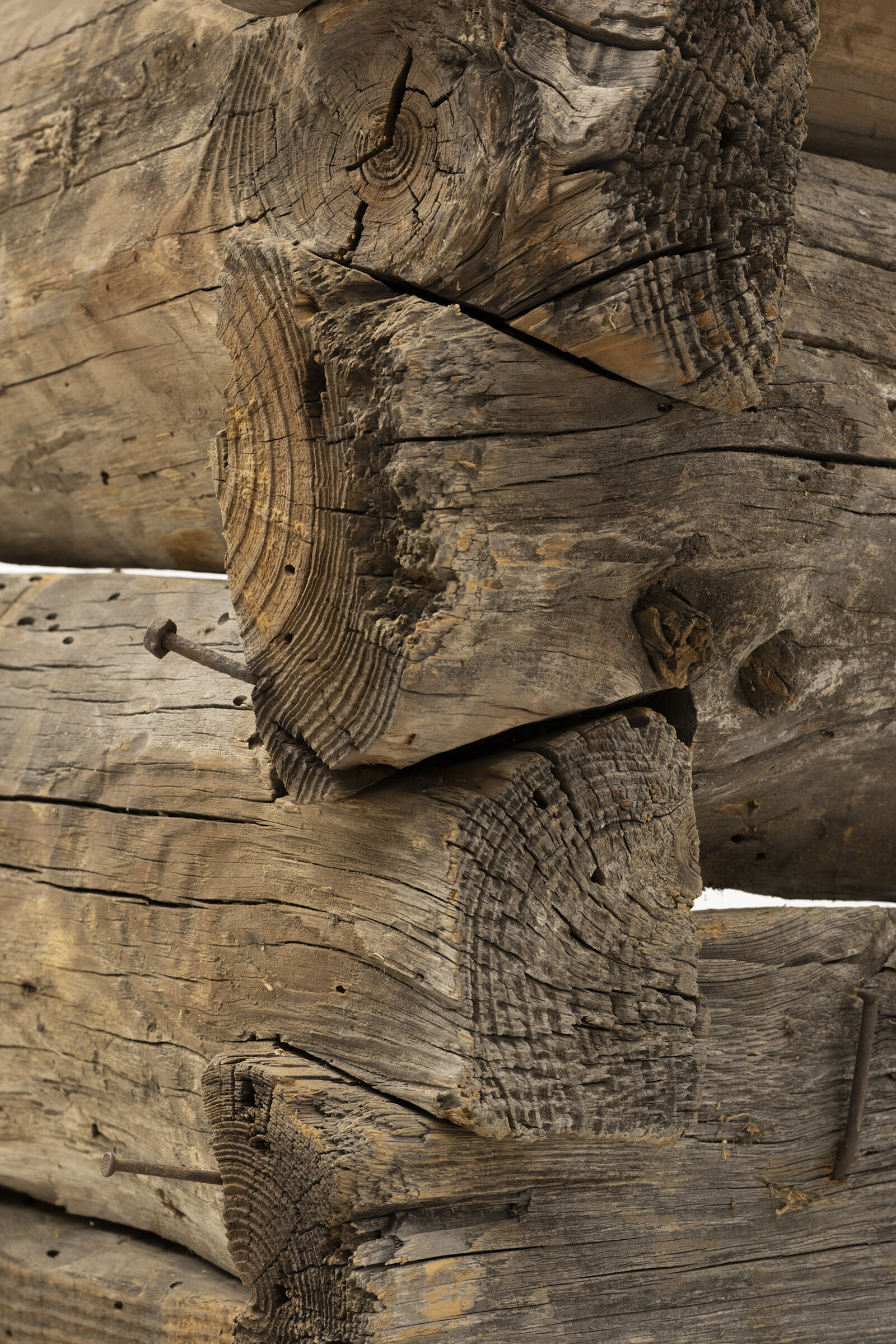As much arsonist as archivist, Augustas Serapinas takes an irreverent approach to remnants of the past. In 2012 he transformed student artworks discarded at the Estonian Academy in Tallinn into strange-looking gym equipment. For the inaugural exhibition of his London gallery Emalin in 2016, he repurposed materials left by the locksmith who previously occupied the building to create a functioning sauna. And in 2018 he invited children of workers from a decommissioned nuclear power station in his native Lithuania to create a sculpture using rubble from the Soviet-era site. In each fraught context, he intervenes with light-hearted acts of creative destruction, fostering new forms of sociability and use value rather than worshipping at the altar of cultural heritage.
An ongoing strand of Serapinas’s practice involves acquiring and pulling apart dilapidated log-and-shingle buildings, reconfiguring and sometimes charring the scavenged materials, then presenting them in exhibition spaces. Examples of this architectural vernacular survive from as long ago as the nineteenth century in Lithuania as well as over the border in Poland and Belarus. They are prevalent in and around the Polish city of Białystok and feature throughout his current show, filling the Galeria Arsenał elektrownia with the musky smells of damp wood and lichen.
Four segments of shingle cladding hang in a neat row by the entrance. Still populated by bugs and spiderwebs, they warp away from the wall as if resisting their sterile new setting. At first glance Serapinas’s rustic artifacts look like pieces of folk kitsch, preserved in the gallery to affirm a reductive opposition between pre-modern and modern, local past and global present. He unsettles this primitivizing discourse, though, by foregrounding unexpected modernist ideals—functional form, material honesty, modularity—in the techniques of traditional joinery. Cut square and burnt black, the shingle panels recall avant-garde icons: created through destruction like Malevich’s Black Square (1915), shorn from a potentially endless geometry like Mondrian’s grids.
Old log-and-shingle buildings occupy an ambiguous position in local society. Some are seen as historical landmarks, purchased by open-air museums and admired as part of a folklore craze. Many more are considered obstacles to progress or even fuel for pernicious regional stereotypes and given away for firewood, destroyed in arson attacks linked to property developers, or left to rot. A newcomer in Białystok, I seek to pinpoint their significance, but the more questions I ask the more their meaning fragments, and most people regard them with indifference. Serapinas seems to like the way they frustrate the desire for easy access to cultural insight, the kind of ethnographic consumption usually promised by the isolation of artifacts in a gallery. His practice works with local surroundings not to neatly package context but to render it unpackageable—always multiple, unstable, opaque. In interviews he stresses his own status as an “outsider” in the communities where he has orchestrated projects.1 “You don’t feel a full story,” he says about his exhibitions, “because I am not really aware of the full story myself.”2
An installation filling the elektrownia’s second room gives form to this approach, thwarting any search for unity or depth. Serapinas has taken three square log houses, split each in two to create six V-shaped sections and lined these up to form a central corridor through the space. Two contained areas at either side are accessible by doorways that cut through the logs. Crucially, the left-hand walls are turned inside out so their weathered exterior corners point toward the more neatly finished inside corners on the right. This ensures that although viewers can walk endlessly through the doorways, they never have the reassuring sensation of entering an enclosed interior. The tall zigzagging walls, meanwhile, make it impossible to perceive the structure as a whole: approaching one corner always requires concealing another. Serapinas takes the wood cabin—a romantic symbol of pre-modern wholeness and stability—and unfolds it to construct a maze without center, an architecture without place. Notched-log joinery’s modularity becomes a metaphor for the slippery relation between object and context. And not just a metaphor, as this technology was favored in part because it allowed buildings to be relocated, between housing markets, villages, and towns.
According to the curatorial text, for Serapinas the social interactions required to make an exhibition are “the real core of the artistic process.” His log-and-shingle works should not be read as finished sculptures but extended performances involving carpenters, curators, owners of wood buildings and folk culture enthusiasts, van drivers, gallerists and collectors, in which architectural fragments are continually reconfigured across exhibitions. With each iteration, the network of people expands while the materials further degrade: later this month the artist will open a show in Chur featuring a wooden bathhouse displayed whole in 2021 now burnt to ash and turned into soap. This peculiar mix of sociability and entropy can be seen as a celebration of use value against the anthropological violence of heritage fetishism, a visualization of the way objects shimmer with social worth in their moments of destruction.
Most of the human interactions, though, happen before and after the exhibition. What viewers encounter are fragile artifacts silently awaiting their next disruption, which provokes a reading of the work less comfortable for its host institutions. Publicly dispersing and destroying historical remnants over time, Serapinas’s practice presents the art industry—its values and infrastructures—as a force more destructive than the elements, one that undermines and privatizes dreams of locality and stability. The gallery becomes a captivating but nihilistic place in which we are encouraged to enjoy the splintering of stories and the hollowing out of the potentially meaningful.
Travis Jeppesen, “Augustas Serapinas in the Studio,” Art in America (March 2017), 114–121; Hannah Kocevar, “Augustas Serapinas: Artist-in-Residence,” Kunsthalle Wien Blog (28 January 2015).
Guy Mackinnon-Little, “Augustas Serapinas,” Tank (May 2019), https://magazine.tank.tv/tank/2019/05/augustas-serapinas.
